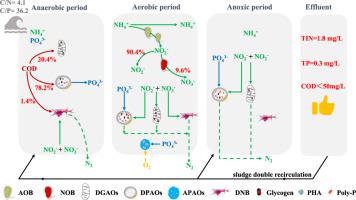当前位置:
X-MOL 学术
›
Water Res.
›
论文详情
Our official English website, www.x-mol.net, welcomes your
feedback! (Note: you will need to create a separate account there.)
Achieving ultra-high nitrogen and phosphorus removal from real municipal wastewater in a novel continuous-flow anaerobic/aerobic/anoxic process via partial nitrification, endogenous denitrification and nitrite-type denitrifying phosphorus removal
Water Research ( IF 11.4 ) Pub Date : 2023-12-20 , DOI: 10.1016/j.watres.2023.121046 Chuanfeng Zhang 1 , Liang Zhang 1 , Jinjin Liu 1 , Xiyao Li 1 , Qiong Zhang 1 , Yongzhen Peng 1
Water Research ( IF 11.4 ) Pub Date : 2023-12-20 , DOI: 10.1016/j.watres.2023.121046 Chuanfeng Zhang 1 , Liang Zhang 1 , Jinjin Liu 1 , Xiyao Li 1 , Qiong Zhang 1 , Yongzhen Peng 1
Affiliation

|
Achieving economic and efficient removal of nutrients in mainstream wastewater treatment plants (WWTPs) continues to be a challenging research topic. In this study, a continuous-flow anaerobic/aerobic/anoxic system with sludge double recirculation (AOA-SDR), which integrated partial nitrification (PN), endogenous denitrification (ED) and nitrite-type denitrifying phosphorus removal (nDNPR), was constructed to treat real carbon-limited municipal wastewater. The average effluent concentrations of total inorganic nitrogen (TIN) and PO4 3− -P during the stable operation period were 1.8 and 0.3 mg/L, respectively. PN was achieved with an average nitrite accumulation ratio of 90.4 % by combined strategies. Adequate storage of polyhydroxyalkanoates and glycogen in the anaerobic zone promoted the subsequent nitrogen removal capacity. In the anoxic zone, nitrite served as the main electron acceptor for the denitrifying phosphorus removal process. Mass balance analysis revealed that nDNPR contributed to 23.6 % of TIN removal and 44.7 % of PO4 3− -P removal. The enrichment of Nitrosomonas (0.45 %) and Ellin 6067 (1.31 %), along with the washout of Nitrospira (0.15 %) provided the bacterial basis for the successful implementation of PN. Other dominant endogenous heterotrophic bacteria, such as Dechlormonas (10.81 %) and Candidatus Accumulibacter (2.96 %), ensured simultaneous nitrogen and phosphorus removal performance. The successful validation of integrating PN, ED and nDNPR for advanced nutrient removal in the AOA-SDR process provides a transformative technology for WWTPs.
中文翻译:

通过部分硝化、内源反硝化和亚硝酸盐型反硝化除磷的新型连续流厌氧/好氧/缺氧工艺实现真实城市污水的超高脱氮除磷
在主流废水处理厂 (WWTP) 中实现经济高效的营养物去除仍然是一个具有挑战性的研究课题。本研究构建了一套集部分硝化(PN)、内源反硝化(ED)和亚硝酸盐型反硝化除磷(nDNPR)于一体的污泥双再循环连续流厌氧/好氧/缺氧系统(AOA-SDR)。处理真正的碳限制城市废水。稳定运行期间出水平均总无机氮(TIN)和PO43−P浓度分别为1.8和0.3 mg/L。通过组合策略,实现了 PN 平均亚硝酸盐积累率为 90.4%。厌氧区充足的聚羟基脂肪酸酯和糖原的储存促进了后续的脱氮能力。在缺氧区,亚硝酸盐作为反硝化除磷过程的主要电子受体。质量平衡分析表明,nDNPR 贡献了 23.6% 的 TIN 去除率和 44.7% 的 PO43−-P 去除率。亚硝化单胞菌 (0.45%) 和 Ellin 6067 (1.31%) 的富集,以及硝化螺菌 (0.15%) 的洗脱,为 PN 的成功实施提供了细菌基础。其他占优势的内源异养细菌,如 DeChromonas (10.81 %) 和 Candidatus Accumulibacter (2.96 %),确保了同时脱氮和除磷的性能。在 AOA-SDR 工艺中集成 PN、ED 和 nDNPR 进行高级营养物去除的成功验证为污水处理厂提供了一项变革性技术。
更新日期:2023-12-20
中文翻译:

通过部分硝化、内源反硝化和亚硝酸盐型反硝化除磷的新型连续流厌氧/好氧/缺氧工艺实现真实城市污水的超高脱氮除磷
在主流废水处理厂 (WWTP) 中实现经济高效的营养物去除仍然是一个具有挑战性的研究课题。本研究构建了一套集部分硝化(PN)、内源反硝化(ED)和亚硝酸盐型反硝化除磷(nDNPR)于一体的污泥双再循环连续流厌氧/好氧/缺氧系统(AOA-SDR)。处理真正的碳限制城市废水。稳定运行期间出水平均总无机氮(TIN)和PO43−P浓度分别为1.8和0.3 mg/L。通过组合策略,实现了 PN 平均亚硝酸盐积累率为 90.4%。厌氧区充足的聚羟基脂肪酸酯和糖原的储存促进了后续的脱氮能力。在缺氧区,亚硝酸盐作为反硝化除磷过程的主要电子受体。质量平衡分析表明,nDNPR 贡献了 23.6% 的 TIN 去除率和 44.7% 的 PO43−-P 去除率。亚硝化单胞菌 (0.45%) 和 Ellin 6067 (1.31%) 的富集,以及硝化螺菌 (0.15%) 的洗脱,为 PN 的成功实施提供了细菌基础。其他占优势的内源异养细菌,如 DeChromonas (10.81 %) 和 Candidatus Accumulibacter (2.96 %),确保了同时脱氮和除磷的性能。在 AOA-SDR 工艺中集成 PN、ED 和 nDNPR 进行高级营养物去除的成功验证为污水处理厂提供了一项变革性技术。


















































 京公网安备 11010802027423号
京公网安备 11010802027423号